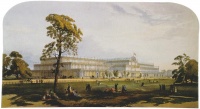The Crystal Palace
From The Art and Popular Culture Encyclopedia

|
"Iron had been used constructionally in combination with glass as early as the middle of the century — as in the Crystal Palace in London [...] but engineering and architecture were still divorced, and in most buildings where these materials served in engineering construction their use was hidden by exterior coverings until in the Eiffel Tower (1889) it stood forth in complete freedom and pointed the way to new forms."--Gardner's Art Through the Ages (1926) by Helen Gardner "With this exhibition, the bourgeoisie of the world has erected in the modern Rome its Pantheon, where, with self-satisfied pride, it exhibits the gods which it has made for itself."--Karl Marx and Frederick Engels in Neue Rheinische Zeitung (1850) "The Crystal Palace of 1851 was the astonishment and delight of the millions who visited it, and long will the recollection of its glories remain impressed upon their minds. But the new Palace of Glass-the Palace of the People-has, to an immeasurable extent, increased the attractions and advantages that belonged to its predecessor."--Tallis's History and Description of the Crystal Palace (1852) by John Tallis |
|
Related e |
|
Featured: |
The Crystal Palace was an iron and glass building originally erected in London's Hyde Park to house the Great Exhibition of 1851. More than 14,000 exhibitors from around the world were gathered inside to display examples of the latest technology developed in the Industrial Revolution. Designed by Joseph Paxton, the Great Exhibition building was 1,850 feet in length (560 m) and 110 feet (33 m) tall.
After the exhibition the building was moved to what is now Upper Norwood where it was enlarged, and stood from 1854 until 1936. It attracted many thousands of visitors from all levels of society. The name Crystal Palace was coined by the satirical magazine Punch.
Influence
The Crystal Palace was the prototype for several other buildings, including the New York Crystal Palace of 1853, the Glaspalast in Munich of 1854, and the Palácio de Cristal in Porto of 1865.
The New York Crystal Palace was built for the Exhibition of the Industry of All Nations for the 1853 World's Fair on a site behind the Croton Distributing Reservoir, between Fifth and Sixth Avenues on 42nd Street (today's Bryant Park). The building was shaped as a Greek cross by the architects George Carstensen and Charles Gildemeister.
Only three years after The Crystal Palace in London the German Glaspalast in Munich was opened for the Erste Allgemeine Deutsche Industrieausstellung on 15 July 1854. The Glaspalast, ordered by King Maximillian II of Bavaria and designed by August von Voit, hosted the biggest art exhibitions and international trade fairs before it burned down in 1931. The fire in the Glaspalast damaged more than 1,000 paintings and sculptures and destroyed more than 110 artworks from the early 19th century including many paintings from Caspar David Friedrich, Moritz von Schwind, Karl Blechen and Philipp Otto Runge.
The Crystal Palace in popular culture
The Crystal Palace made a strong impression on visitors coming from all over Europe, including a number of writers. It soon became a symbol of modernity and civilization, hailed by some and decried by others.
- Fyodor Dostoevsky's narrator in Notes from Underground thinks that human nature will prefer destruction and chaos to the harmony symbolized by the Crystal Palace.
- German philosopher Peter Sloterdijk uses the Crystal Palace as a metaphor for the European project.
See also

